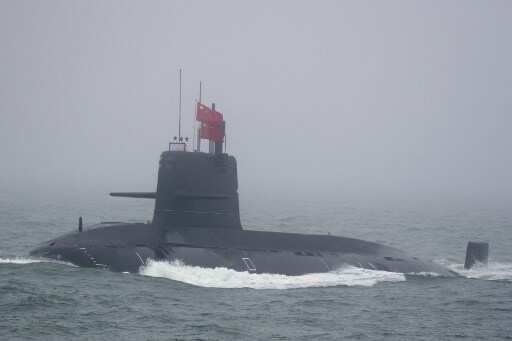beijingwalker
ELITE MEMBER

- Joined
- Nov 4, 2011
- Messages
- 65,191
- Reaction score
- -55
- Country
- Location
World’s Largest Navy: China sets world record according to World Record Academy

November. 06 2021
ARLINGTON, Virginia, United States--With 355 ships in its fleet, according to the Pentagon’s annual China military report estimates, the People’s Liberation Army Navy (PLAN) of China sets the world record for the Largest Navy, according to the WORLD RECORD ACADEMY.
The 355 estimation accounts for “major surface combatants, submarines, aircraft carriers, ocean-going amphibious ships, mine warfare ships, and fleet auxiliaries,” according to the report, which covers events in 2020.
By 2030, the PLAN is expected to have 460 ships.
“This figure does not include 85 patrol combatants and craft that carry anti-ship cruise missiles (ASCMs). … Much of this growth will be in major surface combatants,” the report reads.
According to the Pentagon, the PLAN has 350 battle force ships, as opposed to the U.S. Navy's 293 ships. The U.S. Navy is far larger by tonnage, but that advantage could be erased given China’s frantic shipbuilding schedule.
The report, which is mandated by Congress each year, describes China’s navy as having growing ambitions to operate with more versatile platforms beyond the Indo-Pacific region.
“Towards the PRC’s goal of building a ‘strong and modernized naval force,’ the PLAN is an increasingly modern and flexible force that has focused on replacing its previous generations of platforms that had limited capabilities in favor of larger, modern multi-role combatants,” the report reads.
“As of 2020, the PLAN is largely composed of modern multi-role platforms featuring advanced anti-ship, anti-air, and anti-submarine weapons and sensors. The PLAN is also emphasizing maritime joint operations and joint integration within the PLA. This modernization aligns with the PRC’s growing emphasis on the maritime domain and increasing demands for the PLAN to operate at greater distances from China.”
According to the military report, China is pursuing both new anti-submarine warfare capabilities and long-range strike capabilities, including land-attack cruise missiles that could be launched from surface ships and submarines.
“In the near-term, the PLAN will have the capability to conduct long-range precision strikes against land targets from its submarine and surface combatants using land-attack cruise missiles, notably enhancing the PRC’s global power projection capabilities,” the report reads. “The PRC is enhancing its anti-submarine warfare (ASW) capabilities and competencies to protect the PLAN’s aircraft carriers and ballistic missile submarines.”

 www.worldrecordacademy.org
www.worldrecordacademy.org
November. 06 2021
ARLINGTON, Virginia, United States--With 355 ships in its fleet, according to the Pentagon’s annual China military report estimates, the People’s Liberation Army Navy (PLAN) of China sets the world record for the Largest Navy, according to the WORLD RECORD ACADEMY.
The 355 estimation accounts for “major surface combatants, submarines, aircraft carriers, ocean-going amphibious ships, mine warfare ships, and fleet auxiliaries,” according to the report, which covers events in 2020.
By 2030, the PLAN is expected to have 460 ships.
“This figure does not include 85 patrol combatants and craft that carry anti-ship cruise missiles (ASCMs). … Much of this growth will be in major surface combatants,” the report reads.
According to the Pentagon, the PLAN has 350 battle force ships, as opposed to the U.S. Navy's 293 ships. The U.S. Navy is far larger by tonnage, but that advantage could be erased given China’s frantic shipbuilding schedule.
The report, which is mandated by Congress each year, describes China’s navy as having growing ambitions to operate with more versatile platforms beyond the Indo-Pacific region.
“Towards the PRC’s goal of building a ‘strong and modernized naval force,’ the PLAN is an increasingly modern and flexible force that has focused on replacing its previous generations of platforms that had limited capabilities in favor of larger, modern multi-role combatants,” the report reads.
“As of 2020, the PLAN is largely composed of modern multi-role platforms featuring advanced anti-ship, anti-air, and anti-submarine weapons and sensors. The PLAN is also emphasizing maritime joint operations and joint integration within the PLA. This modernization aligns with the PRC’s growing emphasis on the maritime domain and increasing demands for the PLAN to operate at greater distances from China.”
According to the military report, China is pursuing both new anti-submarine warfare capabilities and long-range strike capabilities, including land-attack cruise missiles that could be launched from surface ships and submarines.
“In the near-term, the PLAN will have the capability to conduct long-range precision strikes against land targets from its submarine and surface combatants using land-attack cruise missiles, notably enhancing the PRC’s global power projection capabilities,” the report reads. “The PRC is enhancing its anti-submarine warfare (ASW) capabilities and competencies to protect the PLAN’s aircraft carriers and ballistic missile submarines.”

World’s Largest Navy: China sets world record
ARLINGTON, Virginia, United States--With 355 ships in its fleet, according to the Pentagon’s annual China military report estimates, the People’s Liberation Army Navy (PLAN) of China sets the world record for the Largest Navy, according to the WORLD RECORD ACADEMY.



